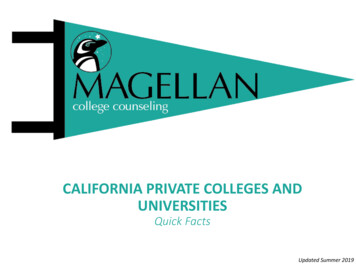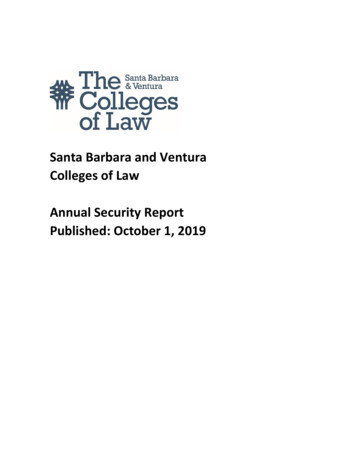
Transcription
Santa Barbara and VenturaColleges of LawAnnual Security ReportPublished: October 1, 2019
Table of ContentsI.GEOGRAPHY AND MAINTENANCE OF CAMPUS BUILDING AND GROUNDS . 3II.LIST OF CAMPUS SECURITY AUTHORITIES (“CSA”) . 4III.Emergency Response and Evacuation Procedures . 4A.Notification. 5B.Evacuation Procedures . 6C.Reviewing, Testing, and Updating the Plan. 6IV.TIMELY WARNING PROCEDURES . 7V.REPORTING INCIDENTS & CRIMES . 7A.Confidential Reporting Procedures . 8B.Non-Emergency Contacts: . 8C.Emergency Contacts: . 8VI.POLICY ON CAMPUS LAW ENFORCEMENT. 8VII.DRUG AND ALCOHOL REGULATIONS AND POLICIES . 9VIII.DISCLOSURE OF DISCIPLINARY PROCEEDING RESULTS . 10IX.SEXUAL MISCONDUCT POLICY . 10A.General . 10B. Procedures for Students. 11Making a Report to Law Enforcement . 11Making a Report to COL . 11C. Notification of Rights and Options and Preservation of Evidence . 12Survivors of sexual misconduct have the following rights and options: . 12Preservation of Evidence: Procedures Survivors Should Follow . 12Options for Resolution . 13D. Interim Protective measures . 15E. Sanctions . 15F. Awareness/ Prevention and Ongoing Prevention Programs . 16G. Bystander Intervention . 16H. Risk Reduction Tips . 17X.POLICY ON REGISTERED SEX OFFENDER INFORMATION . 18XI.COUNSELING, TREATMENT, OR REHABILITATION PROGRAMS. 18XII.ANNUAL DISCLOSURE OF CRIME STATISTICS . 19Collection of Statistics for Annual Security Report . 19CONTACT US . 262
Crime Awareness and Campus SecurityInformation ReportSeptember 2019This report is provided to meet the requirements of the Jeanne Clery Disclosure of Campus SecurityPolicy and Campus Crime Statistics Act of 1988 and has been prepared by The Santa Barbara andVentura Colleges of Law (“COL” or “Colleges”) using statistical and other information supplied by theSanta Barbara and Ventura Police Departments and Campus Security Authorities.I.GEOGRAPHY AND MAINTENANCE OF CAMPUS BUILDING ANDGROUNDSThe Santa Barbara and Ventura Colleges of Law is a private, nonprofit postsecondary institutionoffering graduate-level education programs in the study of law. The college has two campuses, one inSanta Barbara at 20 E. Victoria, Santa Barbara, CA 93101 and one in Ventura at 4475 Market Street,Ventura, CA 93003. Some COL students participated in a study abroad trip in South Africa fromDecember 1, 2018 through December 11, 2018. For that trip, Colleges of Law (COL) rented hotel roomsfor students. The hotel rooms and related spaces are deemed “non-campus property” for purposes ofthe Clery Act. As of Fall 2019, the Santa Barbara (“SB”) campus had enrollment of 81 students, and theVentura Campus had enrollment of 83 students. At both campuses, classes are held in the evening.Therefore, it is required that our facilities be open at night. Although the facilities can be locked afterbusiness hours, it is imperative that staff, faculty, and students cooperate to keep closed facilitieslocked, protect the security of campus keys, access codes and report immediately the loss or theft ofkeys. Students, faculty and staff should exercise common-sense safety precautions at all time while oncampus.We attempt to maintain our facilities in a manner that minimizes hazardous conditions. Regularwalkthroughs are conducted by the campus staff. Malfunctioning lights or other unsafe physicalconditions should be reported to administrative staff for correction. In addition, COL invites reports ofphysical hazards (e.g., broken furniture, spills, plumbing problems, electrical problems, etc.) to ourBusiness Manager, Alexis Burdick at 805-765-9307 or colfacilities@collegesoflaw.edu.3
II.LIST OF CAMPUS SECURITY AUTHORITIES (“CSA”)While students are encouraged to report crimes to the police, they are also urged to report anyincidents to a campus security authority listed below for proper incident tracking. The currentdesignated CSAs and their titles are: Student Services Coordinator (VTA) – Jennifer Mackie, 805-765-9301;jmackie@collegesoflaw.edu Student Services Coordinator (SB) – Ruby Baer, 805-979-9353;rbaer@collegesoflaw.edu Assistant Registrar & Program Manager for Onsite and Special Programs –Christian Winnewisser, 805-979-9862; cwinnewisser@collegesoflaw.edu Registrar – Barbara Doyle (VTA), 805-765-9302;bdoyle@collegesoflaw.edu Business Manager – Alexis Burdick, 805-765-9307;alexisburdick@collegesoflaw.eduThis list is maintained at n/. The BusinessManager will track all reported crime statistics and will use the incident report form, located ion/, along with information provided by local lawenforcement in compiling the statistics. The incident report form may be filled out by students, faculty,staff, or a designated CSA. Hard copies are also available at the reception desks at both campuses andcan be turned in to CSAs for proper handling and tracking.Emergency Response and Evacuation ProceduresIII.In cases of emergency, an Emergency Operations Plan (“EOP”) has been designed to provide facultyand staff with information in identifying the protocol if and when an “event” occurs that mayjeopardize the health or safety of those on campus and/or prevents COL from continuing its normaldaily operations. The EOP is available on the School’s Emergency Information webpage ion/.In the event of a campus emergency (e.g., medical emergency, fire, evacuation, and/or any eventwhere 911 is called), the EOP Administrator/Business Manager, Alexis Burdick, should be notified bycalling: Santa Barbara: (805) 979-9860; After Hours: (805) 207-3674 or (805) 207-3129 (Securitas Patrol) Ventura: (805) 765-9300; After Hours: (805) 207-3131 (Securitas Patrol)The EOP Administrator has initial responsibility for contacting the Emergency Response Team (“ERT”)Leadership Team to initiate emergency protocols, which include situation assessment and activatingappropriate response plans, e.g., campus evacuation, campus closure, and other situational actions.4
Until the ERT Leadership Team lead can be contacted, or the EOP Administrator is relieved by higherauthority or local authorities, the EOP Administrator will direct all available COL resources to providepriority protection for life, safety, and preservation of property.It is the policy of COL to involve local authorities when it is determined that a particular campusemergency exceeds the capabilities of institution’s personnel. The Colleges will seek the assistance ofthe municipal police department, fire department and other local agencies on an as needed basis. COLwill then coordinate with such local agencies and comply with their directives. In addition, COL hasrequested cooperation from both Ventura and Santa Barbara Police Departments to inform theBusiness Manager at the Colleges of Law of any crimes that may warrant an emergency response.A. NotificationNo single system can be 100 percent effective, therefore Colleges of Law uses multiple independentcommunication channels to make sure that information is dispersed quickly to students, faculty, staff,and other members of the Colleges of Law community in the event of an emergency (see Figure 1).Figure 1: Emergency Response ProtocolContact information for the COL community is updated on an ongoing basis using the studentinformation system and/or human resources systems. Additionally, an annual request goes out tostudents to be sure any updates to contact information have been recorded.COL will, without delay, and taking into account the safety of the community, determine the content ofthe notification and initiate the notification system, unless issuing a notification will, in the professionaljudgment of responsible authorities, compromise efforts to assist a victim or to contain, respond to orotherwise mitigate the emergency. The ERT Communications Team will determine information to bereleased and to which constituencies (faculty, staff, students or other community members).The following methods are used for notification: Rave Alert: The Rave system enables College officials to contact registered members of theColleges of Law via text message, voicemail and/or e‐mail to apprise them of emergencysituations or other ongoing risks to public safety in our campus community. The Rave systemcan be accessed by visiting https://www.getrave.com/login/tcsedsystem.5
Emergency Information on COL Website: In the event of a major emergency, informationabout the status of the College is posted online at /. Email Notifications: The College of Law maintains a list of email addresses for all students,faculty, and staff that can be segmented to distribute timely information about crimes as wellas emergencies and other situations posing a risk to campus safety. Members of the COLcommunity are encouraged to check their Colleges of Law email account for safety and securityinformation. Departmental Phone Tree: COL Administration maintains a stakeholder communication rosterand a phone tree to expedite emergency communications.B. Evacuation ProceduresIn the event an evacuation is initiated, signals will sound and you will receive instructionsfrom the ERT Response Management Team and/or fire officials to evacuate.Follow the procedures below:1. The designated Area Captain (Business Manager in Ventura, Assistant Registrar inSanta Barbara) is to alert the other members of the ERT Response ManagementTeam to assume their duties and begin the evacuation.2. The ERT Response Management Team is to walk the campus making sure thateveryone is aware of the order to evacuate and directs all employees and visitors toproceed quickly to the emergency exit for a safe exit.3. Searchers are to search all rooms including restrooms. After a room has beensearched, close the door and place a post-it at the bottom of the door to indicate tothe fire department that the room has already been searched.4. The Area Captain is the last one to leave the ground level. Before leaving, checkoffices and other rooms that were not inspected (if doors are open and do not havepost-it notes). Make sure all doors are closed because this helps to contain fire andsmoke.5. Once an evacuation has begun, do not re-enter the evacuated area until it has beendeclared safe by the Fire Department officials.6. The Area Captain should take a head count (using a current list of employees) andconfirm that their evacuated personnel are present and accounted for at thedesignated evacuation area. If someone is not accounted for, immediately notify thefire department so that they may send help.C. Reviewing, Testing, and Updating the PlanCOL Administration reviews the EOP annually and will revise the Plan if necessary to incorporatechanges to guidance, standards, or laws concerning emergency responsiveness, changes in institutional6
officers, and changes in hazards or threat profile. Following any emergency event, the EOP will bereviewed and any revisions made that would improve responsiveness to future events. All changesshall be made with the advice and counsel of local authorities. The Emergency Response Team tests theplan on an annual basis and provides a written summary of results and suggested changes to the plan,if any. The Emergency Response Team team intends to conduct one announced emergency drill percalendar year. COL last conducted announced emergency drills May 22, 2017 at 3p.m. (Ventura) andJune 21, 2017 at 11a.m. (Santa Barbara), and is on schedule to conduct 2019 drills at each campus inOctober 2019. During these exercises, the alarm sounds and the campuses clear the buildings, andmeet at a predetermined rendezvous point. COL publicizes its emergency response and evacuationprocedures (Emergency Operation Plan) on its website, which is available to students and /uploads/2017/08/COL emergency operations plan 092116 PUBLIC.pdfIV.TIMELY WARNING PROCEDURESIn addition to the yearly statistics provided in this document and on our website, the Business Managerwill make periodic reports, or Crime Alerts, to the campus community of recent crimes that may affectthe quality of life in the greater campus area. The timely warning policy is included in the EmergencyOperations Plan. These reports are distributed via email, campus flyers, the ormation/, and/or the student Gateway (an onlineportal). These communications are intended to raise awareness regarding criminal activity so thecommunity can increase or implement safety strategies. For crimes considered a threat to otherstudents or employees, victim names will be withheld from timely warnings.Decisions to disseminate a Crime Alert will be decided on a case-by-case basis by the EmergencyResponse Team in light of all the facts surrounding the crime and the continuing danger to the campuscommunity and whether there is any risk that law enforcement efforts would be compromised. CrimeAlerts will contain a brief description of the incident; the date, time, and location of the incident; andprecautions to take. The amount and type of information presented in the warning will vary dependingon the circumstances of the crime. Significant criminal incidents that might elicit a timely warninginclude, but are not limited to, crimes of violence or patterns of property crimes. Anyone withinformation warranting a timely warning should report the circumstances to the Business Manager atcolsafety@collegesoflaw.edu or one of the designated COL CSAs. In addition, COL has requestedcooperation from both Ventura and Santa Barbara Police Departments to inform the Business Managerat the Colleges of Law of any crimes that may warrant timely warnings.V.REPORTING INCIDENTS & CRIMESWhether it happens to you or you are a witness, you have the responsibility to report a crime. If acrime occurs on or around campus, report it immediately to the Business Manager at 805-765-9307 orcolsafety@collegesoflaw.edu, or one of the designated COL CSAs, whose names and contactinformation are listed on page 4 of this report. Incident forms are available from the front deskreception area or on our Emergency Information page. The Business Manager will respond to thereport in accordance with the Emergency Operations Plan.Crimes in progress and crimes that have just occurred should be reported directly to the police bydialing 911. Whenever possible, the actual victim or witness of the crime should call directly. Firsthandinformation is always more accurate and complete. When calling to report a crime or incident, please7
be ready to give information such as: a brief description of what occurred, where the incident occurred,did the suspect(s) have a weapon, where and when was the suspect(s) last seen, what did thesuspects(s) look like (gender, race, age, height, weight, hair color/length, clothing, facial hair, tattoos,scars), and any other relevant information. In addition to the importance of reporting, timelyinformation assists us in developing warnings for the campus.A. Confidential Reporting ProceduresIf you are the victim of a crime and do not want to pursue action within the institutional system or thecriminal justice system, you may still want to consider making a confidential report to the school. Withyour permission, a designee of COL can file a report on the details of the incident without revealingyour identity. In such circumstances, crime victims are encouraged to consider making a confidentialreport to one of the designated campus security authorities. At a minimum, crime victims will receivevaluable counseling and referral information.Confidential reports are important because they provide valuable information that will enhance thesafety of the community-at-large and they will, at least, provide a more accurate portrait of actualcampus crime. The purpose of a confidential report is to comply with your wish to keep the matterconfidential, while taking steps to ensure the future safety of yourself and others. With suchinformation, the school can keep an accurate record of the number of incidents involving students,determine where there is a pattern of crime with regard to a particular location, method, or assailant,and alert the campus community to potential danger. Reports filed in this manner are counted anddisclosed in the annual crimes statistics for the school.Anonymous crime reporting is NOT for emergencies. If you need to report an emergency, call 911.B. Non-Emergency Contacts: Santa Barbara: (805) 979-9860;o After Hours: (805) 207-3674 or (805) 207-3129 (Securitas Patrol)Ventura: (805) 765-9300;oAfter Hours: (805) 207-3131 (Securitas Patrol)C. Emergency Contacts:VI. Santa Barbara Fire Department: (805) 965-5254 Santa Barbara Police Department: (805) 897-2300 Ventura Fire Department: (805) 339-4300 Ventura Police Department: (805) 339-4400POLICY ON CAMPUS LAW ENFORCEMENTCrime prevention is a high priority of campus administrators at Colleges of Law. To achieve this goal,COL works in conjunction with surrounding law enforcement agencies. Additionally, the Venturacampus employs Securitas security company four (4) evenings a week to provide security andassistance in the building and surrounding areas. The security personnel do not have the authority to8
arrest individuals, unless such personnel possess a valid certification as a law enforcement officer,peace officer, or are authorized to act in such capacity by way of official authority granted by a court ofstate regulatory agency. On the Santa Barbara campus, there are currently no security personnel onsite. Neither campus employs campus police.COL community members are strongly encouraged to immediately report criminal activity andsuspicious person(s) to police. Incidents that may or may not be crimes also may be reported tocampus security authorities, which are listed above in Section II, including those with responsibility forcontrolling access to buildings or facilities and officials having significant responsibility for students orcampus activities. Additionally, the Ventura building security will cooperate with local law enforcement.COL does not currently have a Memorandum of Understanding with Santa Barbara or VenturaPolice Department.VII. DRUG AND ALCOHOL REGULATIONS AND POLICIESIn compliance with the Drug Free Schools and Communities Act (DFSCA) of 1986 as amended in 1989,COL explicitly prohibits the unlawful possession, use, or distribution of illicit drugs by students oremployees on School premises or as part of any of its activities. In addition, the School prohibits themisuse of legal drugs including alcohol.Federal penalties and sanctions for illegal possession of a controlled substance are as set forth below.This list has been included for reference purposes only. The most current information can be found onthe website of the U.S. Drug Enforcement Administration.a. First conviction: up to one year imprisonment or a fine of at least 1,000b. After one prior drug conviction: at least 15 days in prison, not to exceed two years, and afine of at least 2,500 but not more than 250,000, or bothc. After two or more prior drug convictions: at least 90 days in prison, not to exceed threeyears, and a fine of at least 5,000d. Special sentencing provisions for possession of crack cocaine: mandatory sentencing of atleast five years in prison, not to exceed 20 years, and a fine of up to 250,000, or both, ifthe first conviction and amount of crack possessed exceeds five grams, the second crackconviction and the amount of crack possessed exceeds three grams, third or subsequentcrack conviction and the amount of crack possessed exceeds one grame. Forfeiture of personal property used to possess or to facilitate possession of a controlledsubstance, if that offense is punishable by more than a one-year imprisonmentf. Forfeiture of vehicles, boats, aircraft, and any other conveyance used to transport orconceal a controlled substanceg. Civil penalty of up to 10,000h. Denial of federal benefits, such as student loans, grants, contracts, and professional andcommercial licenses, for up to one year for first offense or up to five years for second andsubsequent offensesi. Ineligibility to receive or purchase a firearmj. Revocation of certain federal licenses and benefits, (for example, pilot licenses, publichousing tenancy, etc.) as vested within the authorities of individual federal agenciesk. Any person convicted of drug trafficking occurring within 1,000 feet of an academicinstitution is subject to prison terms and fines twice as high as listed above with amandatory prison sentence of one year for each offense.9
Beverage alcohol may be served to and consumed by persons of legal drinking age on School premisesor internships sites only in conjunction with a specifically authorized function of the Schooladministration. Individuals consuming alcohol should do so in a responsible manner.Individuals younger than 21 years old may not purchase, accept as a gift, or possess alcoholic beverageson any street or highway or other public place. Consumption by minors is expressly prohibited.Licensees to sell alcoholic beverages are prohibited from selling, giving, or delivering alcoholicbeverages to anyone under 21 years of age. It is unlawful for anyone of legal age to purchase or obtainalcoholic beverages and then sell, give, or deliver them to a minor.As a condition of matriculation to COL, students agree to abide by the terms of these regulations andpolicies and agree to notify COL of any criminal drug statute conviction for a violation occurring oncampus no later than five (5) business days after such conviction. COL will take appropriate action(consistent with local, state, and federal law) against a student who violates the standards of conductcontained herein, pursuant to the Student Code of Ethics and Conduct, up to and including dismissalfrom the institution and referral for prosecution.The Drug-Free Environment Policy is included in the Academic Catalog. It is also distributed annually toall students and employees pursuant to Public Law 101‐226 (The Drug‐Free Schools and CommunitiesAct Amendment of 1989). COL will regularly review the terms of this policy to:1. Determine its effectiveness;2. Implement changes, as needed, and3. Ensure that sanctions are consistently reinforced.VIII. DISCLOSURE OF DISCIPLINARY PROCEEDING RESULTSCOL will disclose the results of any disciplinary proceeding against a student who is the allegedperpetrator of a crime of violence (as defined by Section 16 of Title 18 of the United States Code, 18U.S.C. §16), or a non-forcible sex offense to the alleged victim. If the alleged victim is deceased as aresult of the crime or offense, the next of kin of the victim shall be treated as the victim for purposes ofnotification.IX.SEXUAL MISCONDUCT POLICYA. GeneralCOL is committed to creating and maintaining a safe learning and working environment that is free ofunlawful discrimination, harassment, exploitation, or intimidation for all members of the COLcommunity. As such, COL prohibits sexual misconduct in all forms, including but not limited to sexualharassment, sexual violence, sexual assault, dating violence, domestic violence and stalking. COL willrespond promptly and effectively to reports of sexual misconduct, and will take appropriate action toprevent, to correct, and when necessary, to discipline behavior in violation of this Policy. COL also barsretaliation against any employee, student, or applicant who files a good faith report of sexual misconductor otherwise participates in an investigation relating to the same.The Sexual Misconduct Policy, which is available here, applies to all COL employees, students, and otherCOL Community Members, regardless of gender/gender identity and sexual orientation, for sexual10
misconduct occurring on COL’s campuses or in connection with its educational programs, activities andservices, or that puts COL Community Members at risk of serious harm or otherwise creates a hostilelearning and/or working environment.COL students, faculty and staff who, after a thorough review of the facts, are found, based on areasonable belief, to have violated this policy will be subject to discipline, up to and including dismissalor termination of employment or dismissal from COL.B. Procedures for StudentsMaking a Report to Law EnforcementCOL encourages Community Members who have experienced sexual misconduct to immediately reportthe incident to the local police department or another area law enforcement agency. Reporting of sexualassault, domestic violence, dating violence, and stalking to the police does not commit the ReportingParty to further legal action. However, the earlier an incident is reported, the easier it will be for thepolice to investigate if the Reporting Party decides to proceed with criminal charges. Early reportingmakes it more likely that the police will be able gather needed evidence before it is lost or destroyed,and that the Reporting Party will receive timely notice of potentially helpful victim/witness services.Making a Report to COLReporting Parties are also encouraged to report incident(s) of sexual misconduct to COL’s Title IXCoordinator, who is:Deborah Jurgensen, Librarian and Title IX CoordinatorThe Santa Barbara and Ventura Colleges of Law20 E. Victoria Street, Santa Barbara, California 931014475 Market Street, Ventura, California ting Parties are not required to report to area law enforcement to receive assistance from orpursue any options within COL. The Title IX Coordinator will provide a Reporting Parties with informationabout available support services and resources, and also assist the Report Party in notifying lawenforcement, including the local police, if the Reporting Party elects to do so.Reporting and Confidentially Disclosing Sexual MisconductCOL encourages victims of sexual misconduct to promptly talk to somebody about what happened, sothey can get the support they need, and so COL can respond appropriately. COL encourages victims totalk to someone identified in one or more of these groups.A Reporting Party should be aware that reporting an incident to COL does not necessarily mean that COLwill report to law enforcement. If a Reporting Party desires that notice be given to law enforcement, theReporting Party should file a report with a law enforcement agency and COL can assist the ReportingParty in doing so.11
Certain campus officials have a duty to report sexual assault, domestic violence, dating violence, andstalking for federal statistical reporting purposes under the Clery Act. All personally identifiableinformation is kept confidential, but statistical information must be passed along to campus securityauthorities regarding the type of incident and its general location (on or off-campus, in the surroundingarea, but no addresses are given) for publication in the Annual Security Report
The Santa Barbara and Ventura Colleges of Law is a private, nonprofit postsecondary institution offering graduate-level education programs in the study of law. The college has two campuses, one in Santa Barbara at 20 E. Victoria, Santa Barbara, CA 93101 and one in Ventura a
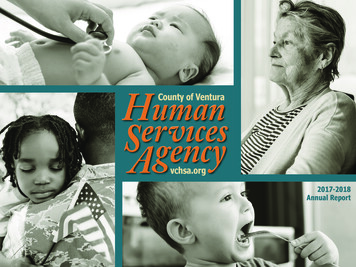
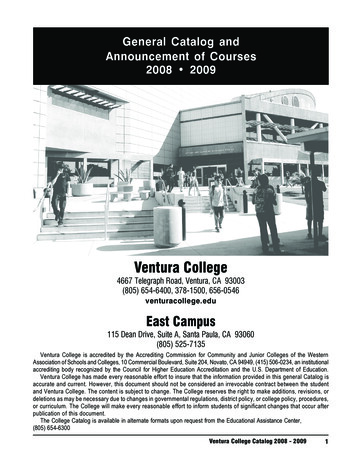

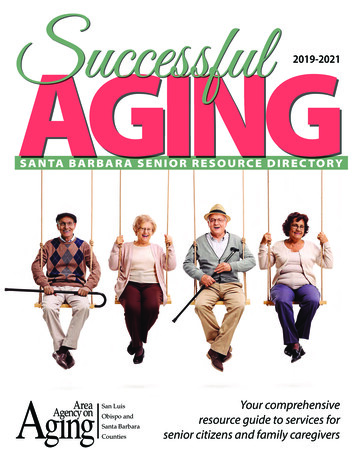


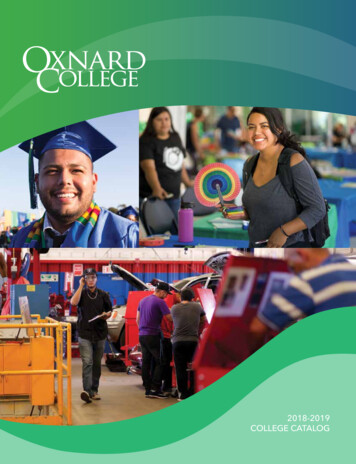
![[TAY SERVICE GUIDE] - Ventura County](/img/26/tay-community-services.jpg)

